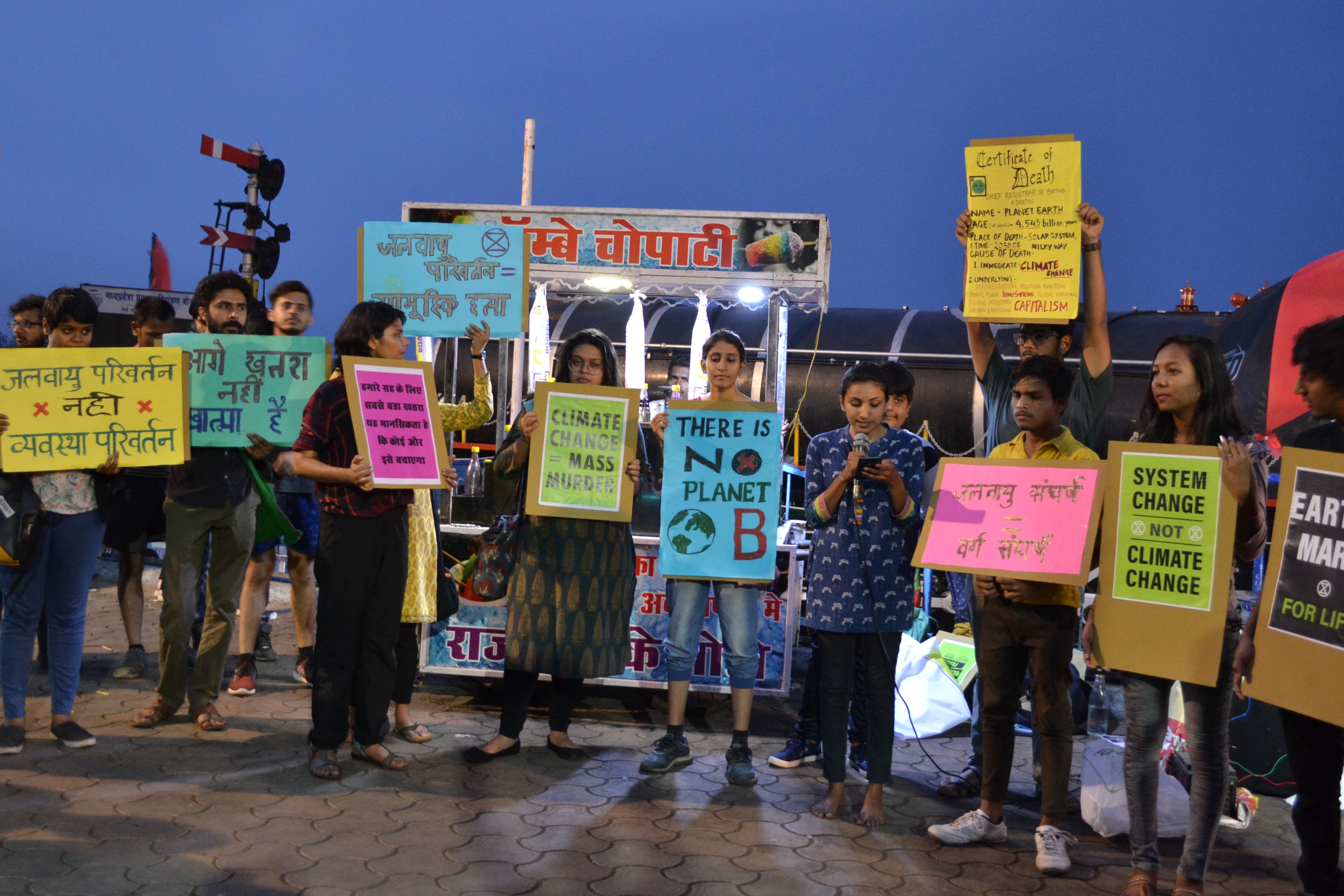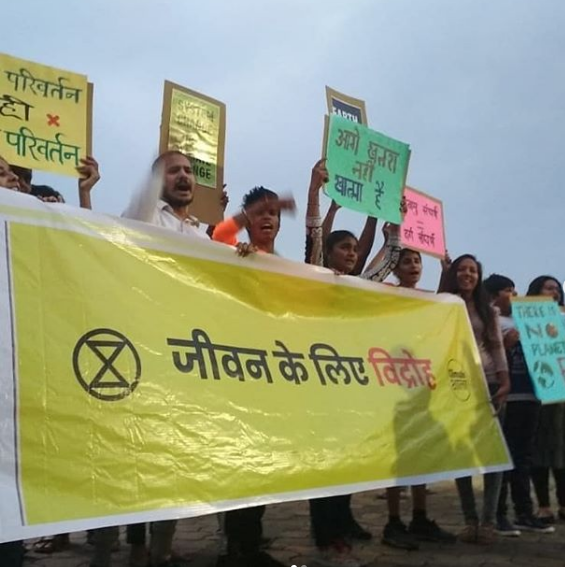Last month, the streets of London went under a state of siege of sorts. Eco-protestors and warriors occupied some of the most prominent public spaces and launched a rather unusual attack. Some glued their breasts to the streets, while a few staged “die-ins”, and a few more chained their necks to fences of well-known establishments.
Towards the end of the month, the city literally came to a halt, a little more than 1,000 protestors were arrested, and the UK Parliament declared a state of climate emergency.
Videos by VICE
The guys who shut down London are a part of Extinction Rebellion (XR), a global movement that believes that mass extinction is happening right here, right now. In an open letter signed in October 2018, 94 XR signatories stated: “We are in the midst of the sixth mass extinction, with about 200 species becoming extinct each day…If we continue on our current path, the future for our species is bleak.”
In India though, climate change is met with a rather casual (and concerning) apathy—even when the rising toll of farmer suicides was linked to it, or droughts have become more intense with each passing year, or, most recently, international reports officially slotting India as one of the top polluted countries in the world. And even while climate change denial has not reached an alarming level, unlike in other countries, the conversation does seem to be missing altogether. “Climate scepticism in India is not an organised conversation, in that they’re not very large business groups, political parties think-tanks where scepticism is being promoted,” Anu Jogesh, the India policy and governance lead at Acclimatise, a climate change risk management organisation, told Al Jazeera last year.
But even then, the theatrical nature of XR seems to have appealed to the climate change evangelists in India. The first instance of a large-scale XR protest in India was reported in March 15 when, coinciding with 16-year-old Greta Thunberg’s iconic climate strikes (which involved over 1.4 million people across the world), XR India organised a protest with 400 school kids in Delhi, followed by 500 primary and high school students staging a protest in Gurgaon. In Bhopal, there was music, dance and recitation of Thunberg’s speech in Hindi during this week of protests.

“In India, we are still in the very initial phase [of XR],” says Sarthak Tomar, a 26-year-old law student who started the XR Bhopal chapter during his own eco-activism last year. “After the October 2018 IPCC Special Report on the impacts of global warming, a couple of friends started a green energy campaign in Bhopal but when XR surfaced in November [globally], we shifted our campaign to XR because their demands, strategies and organisational structure made more sense given the task,” he tells VICE.
The XR movement in India gives the climate threat conversation in the country a long, hard look. “It has been known for a few decades that there is a second existential threat to life on the planet—that of climate and ecological breakdown,” says Tomar. “Once these facts sink in, it’s hard to not devote one’s life to the struggle to mitigate these threats.”
Tomar talks to VICE about some of the worrying facts that India is looking at:
Climate crisis is here already
Several research and scientific reports have warned Indians of impending doom. The latest one, 2018 World Air Quality Report, published by Greenpeace and IQ AirVisual, sees many Indian cities topping the most polluted cities in the world. “India is the third-largest greenhouse emitter and the only country that will continue to increase the emissions due to continued reliance on coal and emission intensive city planning. Despite all the noise about renewables, coal use will continue due to rapidly increasing industries and population,” says Tomar.
Additionally, climate threat is not limited to one aspect of life. “Internally, India will suffer severe water, food shortage, increasing chances of group and mob violence for these resources. It will also further tense the situation with Pakistan over water disputes. India faces a crisis that no amount of fossil-fuel lead development will be able to survive.”

We are an apathetic lot
Even though all it takes for some Indians to mob is one WhatsApp message, it’s clear that climate change will never make the cut for a pissed-off gathering. XR in India, even though in its initial stage, has been struggling to mobilise the environmentally-conscious ever since it formed. Plus, the movement has a strict policy: no violence, and no singling out of individuals to name and shame. “Getting new people to get interested enough to talk to you is very difficult, as well as making sure that they don’t just put it in the back of their head after that,” says Tomar.
“First, you need people willing to take such steps [like the ones taken by London protestors]—there are quite a few in India. But then, you need mass support for these acts—this is lacking in India. You need the police to cooperate with the protesters. This, too, is missing in India. You also need a political environment that will respond to these actions—I doubt this is also present in India,” he says. “But the mass support and political will can be created with different tactics of consciousness-raising and day-to-day struggles.”
The international XR chapters have made it very evident that it can succeed where conventional activism has failed solely by involving the general public. “[The UK XR] has gotten more traction due to years of behind-the-scenes organising, and the more informed and affluent general population—both of which are absent in India,” says Tomar, “What is happening in the UK is not impossible in India. In fact, it could even be done better here but it will take time in maturation.”
The young, the poor and the marginalised have a lot to gain from XR
One of the big victories of international chapters of XR’s “display of civil disobedience” is their all-inclusive nature—it involves people from all generations, class and gender. However, when it comes to inclusion, India is still fraught with questions of basic human needs such as food, shelter and safety, which need to be met before we address environmental protection and compliance.
Tomar acknowledges this gap. “In the Bhopal XR campaign group, people involved are mostly from quite well-to-do middle class backgrounds,” he says. “But young people from marginalised and urban poor communities also do take part. They are impacted most severely due to the crisis and unjust measures taken to mitigate climate change. We want to get more marginal communities involved as soon as possible.”
The XR movement has a lot to achieve by mobilising the migratory and urban poor (not the millennial kind) demographic, who, Tomar says, are the worst affected. “Many of them are only in the city for half the year, working as farmers the rest of the year. That occupation will be more severely hit very soon. Also, the waste-pickers and the garbage collection workers are more affected within the carbon-intensive life cycle of most consumer products.”

Our cities are dying because they’re the problem
We’ve been reading about the death of most major Indian cities such as Delhi, Bengaluru, Mumbai and Kohima, even though our government has had its head in the sand for most part. But Tomar says that all big cities, in general, are a problem. “The people in the city are the one doing the air travel, and they also want to increase it. The groundwater level in most cities in decreasing rapidly. But our lifestyle in the cities makes it harder to notice this—which is probably the biggest problem as it stops any action.
The movement also notes how the cluttered lifestyles is an additional weight on our shoulders: from the competition in schools to mass unemployment to consumerist culture. “It’s a society of atomisation that prefers isolated units of consumption rather than social human activity. That’s why it is harder for people to care about climate change and many other dangers and challenges around us.”
Indian jails can spell trouble for XR activism
One of the key observations of the XR movement in the UK was the number of arrests during the protests—over 1,000 arrests within just eight days of protests. Is India ready for mass civil disobedience for the government to bend the knee? “Civil disobedience means to break the law to make a political statement or to stop an unjust and criminal activity that is legal,” says Tomar.
“Slavery was legal; to break the laws in order to abolish it was justified but still illegal. It was the same with apartheid, and with the fossil fuel economies today. XR calls for civil disobedience. There are no particular laws making it difficult. It is the procedural laws, the condition of the prison system and jails, and sedition laws, among other things, that make the situation in India difficult than more civilised nations. You will get arrested for disobedience anywhereiIt’s what happens to you after you are arrested in India that is different.”
XR India will be a part of another wave of the global Fridays for Future protests on May 24, 2019. Know more here.
Follow Pallavi Pundir on Twitter.




